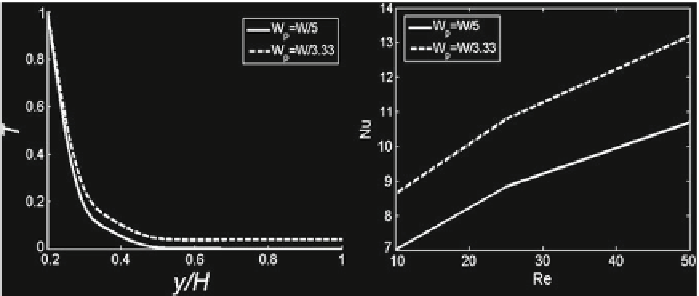Environmental Engineering Reference
In-Depth Information
Fig. 7
Effect of the heater length on the temperature profile at
x
/
H
=
2
.
0 and Nusselt number for
various Reynolds number
heater the fluid temperature does not decay to zero, since more energy is injected
by the heater to the fluid. The right panel of the figure indicates that for a specific
Reynolds number, increasing the length of the heater leads to an increase of the
heat transfer rate. By further increasing the Reynolds number for a given length of
the heater, the heat transfer rate to the fluid is also increased, so more energy can be
transported by the fluid, which therefore causes it to releasemore heat from the cavity.
5 Conclusions
The fluid dynamics, heat and mass transfer in an open cavity for the de composition
of a substance is investigated in this work. The analysis is carried out for the laminar
flow and the governing equations were solved with the finite element method. The
simulations revealed several interesting features concerning the flow structure, ther-
mal and mass transport inside the open cavity as function of the length of the heater
and the Reynolds number. For
Re
10, the concentration at the exit of the cavity
is practically zero and the substance has been completely decomposed. However,
for
Re
=
50 incomplete consumption of the substance is observed and the outlet
concentration is reduced to only about 50% due to higher inlet velocity keeping the
main stream of the flow at lower temperature. On the other hand, if the length of
the heater increases, the temperature inside the cavity is increased due to energy
injection from the plate to the fluid being improved. As a result the decomposition
of the substance inside the cavity is more efficient.
=

Search WWH ::

Custom Search